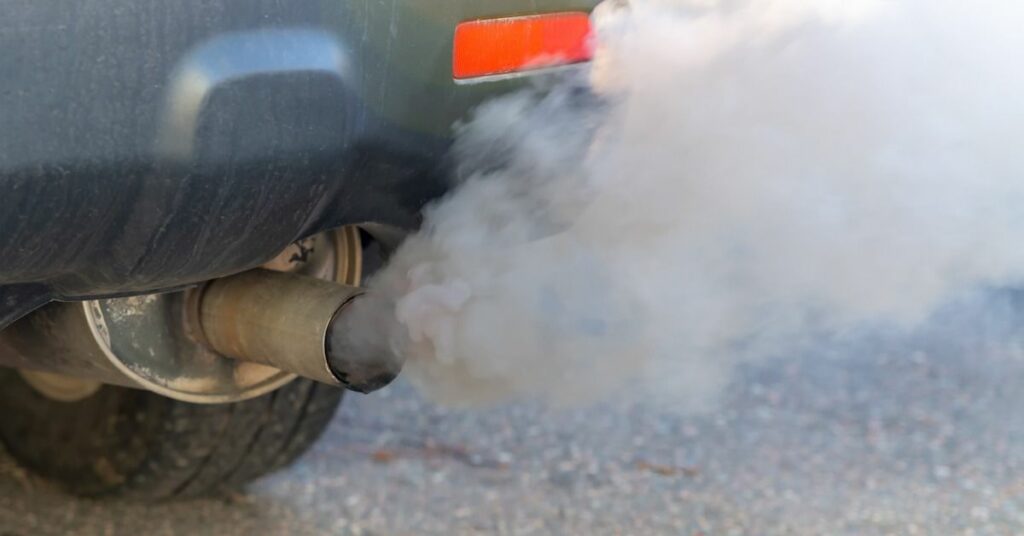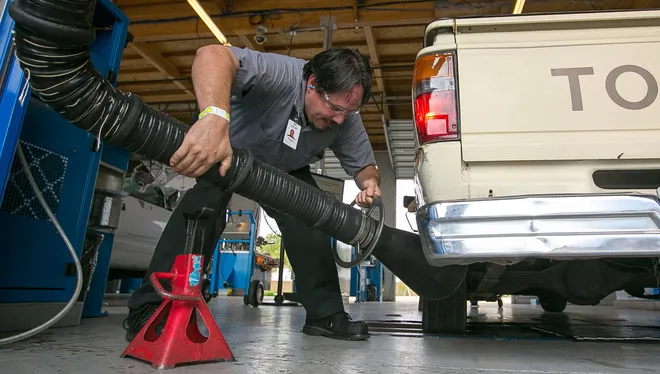Is it time for your car’s registration renewal? Or have you bought a new car that needs an emissions test? Sounds unfamiliar? The emission test is the legal requirement you must meet in order to register your vehicle. But passing the emission test can be a real headache for some people. So if you want to prepare for this special test, keep on reading this blog, and don’t forget to share your test experience in the comment section.
PURPOSE OF EMISSIONS TEST

The emissions test is performed to measure the amount of exhaust your vehicle produces. To ensure accurate results, you must follow the testing procedures. These include warming the car up for at least 10 minutes before taking it on a test drive. Suppose everything goes according to plan and your vehicle passes. In that case, you won’t have to worry about getting another emissions test until it is time for its next registration renewal or smog check in three years (or six years if it’s an older model).
The process of getting an emissions test is quick and easy, so even if your vehicle does fail its first attempt at passing, don’t get discouraged! All cars will be retested on their second attempt, with only minor issues needing to be addressed before they can pass inspection successfully.
HOW HARD IS AN EMISSIONS TEST
Emissions testing is a snap, and most cars don’t have any problems passing. This testing is easy, and most cars pass quickly. Emissions testing is not complex, so you don’t need to worry about it. If you have a car that’s in good shape, passing the emissions test should be no problem. If your car doesn’t pass the emissions test, then it might need some repairs done before it can be driven again.
IMPORTANCE OF EMISSIONS TESTS TO THE ENVIRONMENT

Today’s gasoline engines have come a long way in reducing smog-forming emissions that contribute to urban air pollution and greenhouse gases. Older cars, however, haven’t kept pace with the changes in engine technology. If you drive an old vehicle, it’s more likely to fail an emissions test than a newer one will.
Emissions testing is required in many places as part of your state or local government’s efforts. This is to reduce air pollution and greenhouse gases from cars. The goal of an emissions test is simply to measure the amount of exhaust your vehicle produces when you run it on the dynamometer (a machine that measures motor performance).
WHAT IS THE COVERAGE OF AN EMISSIONS TEST?
Measures the pollutants coming out of your vehicle’s tailpipe.
The emissions test is a quick, inexpensive way to check your vehicle’s tailpipe emissions. It measures the number of harmful pollutants coming out of your vehicle’s exhaust pipe and compares them to EPA standards. The test results can be used by mechanics to diagnose problems with your engine and recommend repairs that will reduce harmful pollution.
The emissions test only measures the pollutants coming out of your vehicle’s tailpipe. It does not measure any other components of your car (such as fuel injectors or catalytic converters). This means that the diagnostic evaluation is more thorough than an emissions test; however, it also costs more money.
Diagnostic evaluation
A diagnostic evaluation is a more in-depth test that measures pollutants coming from inside your engine. This type of test requires a mechanic, as it’s not something you can do yourself.
The mechanic will use specialized tools and equipment to find the source of any problems with your car’s emissions system, then make the necessary repairs to fix them. It’s important to note that this process may not always be covered by your warranty, so be sure to keep track of what work was done if you decide to go through with it yourself!
Emissions testing, however, only measures the pollutants coming out of your vehicle’s tailpipe after the car has warmed up. This is to ensure the vehicle is running at normal operating temperature. This helps ensure that emissions are minimized—and no one wants to see their vehicle’s tailpipe spewing hot ash or toxic sludge if it were to happen while testing!
Traditional emissions test
Emissions tests measure pollutants in the exhaust, not engines. Traditional emissions test only measure the contaminants in your tailpipe before leaving the car. While this is essential information to have, it doesn’t tell you anything about what’s happening inside your engine. That’s because traditional emissions tests do not measure any of the pollutants that might be produced by a faulty oxygen sensor or other problems with your engine.
EMISSIONS TEST vs. DIAGNOSTIC TEST
As explained above, the emissions test differs from the diagnostic test. While an emissions test measures the amount of carbon dioxide leaving your tailpipe, a diagnostic evaluation would measure how much gasoline or diesel fuel is being burned inside your engine.
Emissions tests are done at stations and require you to drive up so they can check the readings on-site. Diagnostic evaluations take place at repair shops and involve taking apart various parts of your car (such as the ignition system) in order to find problems with them before they cause further damage. These tests are optional but may be covered by insurance if needed after receiving one too many tickets for something like faulty brakes or bald tires (more info on this here).
CHECKLIST FOR EMISSIONS TESTING
| Your vehicle must be tested at an authorized emissions testing station. |
| Understand the test procedures. |
| Understand how to test the vehicle. |
| The following items should be checked before you take your car for inspection: |
| Check all lights, including brake lights, turn signals, and headlights. Make sure that they work correctly and do not emit any unusual noises when activated or when turned on. |
| Also, check that the lights are securely fastened to the vehicle with no loose screws or other issues that may cause problems during inspection time! |
| Do not forget about backup lights. |
| Check the tire pressure, including spare tires and any other tires, with a separate inflation system (tire sealant or inflator kit). |
HOW TO PASS EMISSIONS TEST

Engine Oil and Oil Filter
>>Oil Filter
The engine should be changed at regular intervals. The oil filter needs to be replaced as well because it collects debris and helps prevent it from entering the engine.
>>Engine Oil Level
You can check your vehicle’s oil level by taking off the lid of the dipstick that’s located on top of the car and inserting it into the hole until you reach full capacity. If your vehicle has a “Low” light on its dashboard, make sure you’re checking before that light comes on! If not, then just check once every few months, or when you think about it, everyone’s different!
Gas Cap
The gas cap is crucial for preventing gas fumes from escaping and keeping moisture out of the tank. If you have difficulty closing the gas cap, try using a little bit of petroleum jelly around its edges. This can make it painless to get a good seal.
If you notice that your car is leaking fuel or burns off more than usual, this may be an indication that your gas cap needs replacing because it’s cracked or otherwise damaged. Contact a professional mechanic as soon as possible if your vehicle doesn’t pass inspection despite proper maintenance and no other apparent issues discovered during an inspection.
Fuel Filter
The fuel filter is found between the fuel tank and the fuel pump. It’s covered by your car’s basic warranty, so you don’t have to worry about paying for it.
The use of a fuel filter is to keep dirt and other contaminants out of your engine. If these are allowed into your engine, this can cause damage over time and lead to severe problems like stalling or poor performance. If you haven’t changed yours since you bought your car (or if it was never replaced at all), then now is a good time as any! This can be done quickly through a mechanic or at an auto shop.
Fuel Injection System (if applicable)
Open the hood and inspect the air filter. If you see any dirt, debris, or bugs on the surface of your car’s air filter, you should replace it immediately. The same goes for a wet or damaged filter. If it has been damaged, it needs to be replaced as soon as possible.
Replace your air filter with one that meets your engine’s specifications (make sure they’re compatible).
Ignition Timing
Check for a misfiring engine. Then, adjust it according to your car requirement. After that, check for a vacuum leak. And lastly, don’t forget to check for faulty sensors and fuel injection systems and faulty spark plugs and wires, ignition coils, and more.
Exhaust Gas Recirculation Valve (EGR) System
The EGR valve is a subsystem in your car’s emissions control system. It’s responsible for recirculating exhaust gas back into the combustion chamber to lower combustion temperatures, which reduces emissions. If it fails and you don’t get it fixed, your car will likely fail its emissions test.
When the EGR valve malfunctions, the vehicle may emit a knocking sound when you startup or drive over 45 mph (72 kph). You may also perceive that your engine runs rough and belches black smoke during acceleration. Your mechanic can replace this part with an updated part if needed and will also check all other components of your vehicle’s emissions control systems. Then, inspect how they are functioning together to ensure everything is working correctly before retesting your vehicle after repairs have been completed.
Recirculation System (if applicable)
If your vehicle has a recirculation system, it may have been added to help keep the car cool. But keep in mind that this is optional and does not affect emissions.
Automatic Transmission Fluid Level, Color, and Condition
The automatic transmission fluid (ATF) is a hydraulic fluid used in an automobile’s transmission and transfer cases. The ATF is responsible for shifting gears, cooling the transmission and its components, and regulating oil pressure. If you’re having difficulty shifting gears or if your vehicle vibrates when driving over 40 miles per hour, then it may be time to check your ATF level.
ATF is clear or slightly amber-colored oil with a distinct smell. The color can range from light yellowish to dark brown depending on how long you’ve been driving the car since its last service date or refilling of fluid.
If there are any signs of leaks on your car, such as wet spots on the garage floor, then it’s likely due to an improperly functioning axle seal. Leaks can also indicate worn seals around the transmission pan or even mechanical problems within your gearbox!
REASONS FOR FAILURE
If your car fails an emissions test, it’s not the end of the world. Here are a few issues that can cause you to fail and some ways to fix them:
- Dirty air filter or clogged air intake system
- Faulty spark plugs or ignition coil
- Faulty fuel injectors (one or more)
- Flat spot on engine valves
If you have any of these problems and don’t have time to deal with them immediately, there are still options open for retesting your vehicle. You can also call a mobile mechanic who will come out and fix your car at home or work.
WHAT WILL HAPPEN IF YOU FAIL THE EMISSIONS TEST?
If your car fails the test, you may have to have it repaired and retested. If you don’t want to spend the money on repairs, though, or if there are no repairs that can be made, your only option is not to drive it until the problem is fixed. There are some exceptions for low-income people who cannot afford repairs; in some states, these people can get help from local governments or nonprofits.
BOTTOM LINE
The next time you have to go in for an emissions test, don’t panic. The emissions test is vital for caring for your vehicle, even if you do not care about how the environment is being treated. These tips will help you keep your car as clean as possible while reducing harmful emissions to pass the test. Although some people do fail, it’s not due to anything they did wrong most of the time. Many different factors can lead to a vehicle failing emissions.
That is why, hopefully, this blog can help you a lot to pass the test and care for your car. After this, you can now jump to our next article which talks about car maintenance.
Just click here!
